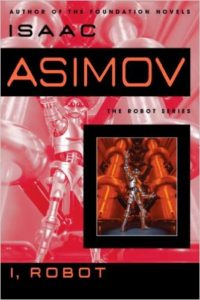Going back to books that I read and enjoyed ages ago can be a hazardous thing. What if the Suck Fairy has paid a visit in the meantime? Should I just let those happy memories lie undisturbed?
I, Robot certainly offered the opportunity. The book that collects nine Asimov stories was first published in 1950. The stories themselves appeared in science fiction magazines as early as 1940. Three quarters of a century have passed; the present day is as far from when Asimov wrote these stories as he was from the end of the American Civil War. The robot stories shaped the field of science fiction, but it has also moved on considerably since then. I don’t know precisely when I first read this book, though it is likely to have been around seventh grade, maybe earlier. I was tearing through everything that the school library and the Baton Rouge public library had to offer in the way of science fiction and fantasy. I remembered the three laws of robotics, but not much else.
Turns out it holds up pretty well for what is now essentially a period piece, a foundational (pardon the word) work. Asimov handwaves artificial intelligence into existence for the purposes of his stories, tames his robots with three laws that are hardwired into their positronic brains, and explores the interesting corner cases. The stories are mostly puzzles. Something has happened with the robots, and they are doing things their manufacturers did not intend. Engineers are called in to figure out why, usually with some kind of deadline looming. In one story, the engineers are marooned on Mercury (interplanetary travel is common in Asimov’s early 21st century) and will die if they cannot get the robot to do something that it ordinarily should not.
The first story, “Robbie,” held the most emotional punch, because it showed a robot through the eyes of a young child, someone not yet able to make the basic distinction that animates most of the rest of the stories, that between robot and human. Later in the sequence, Asimov turns to a fundamental question that would become a staple for other writers, notably Philip K. Dick: What happens when people can no longer distinguish between humans and robots? He doesn’t address the question in depth, but then depth is not the book’s strong suit. It’s nine mid-century short stories, held together by a framework device. The characters are mostly stand-ins for the readers, who get to see how the various puzzles are solved. What you see is very much what you get.
On the other hand, what you see is one of the first concentrated attempts at working through artificial intelligence, and robots in general — what they would be like on an individual level, how society would likely react to them, what some of the second-order effect might be. The field is no longer directly in dialogue with I, Robot, but that’s mainly because it set so much of the framework for how science fiction considers robots and artificial intelligences. This is one of the places science fiction began.


1 ping
[…] Caves of Steel is really the first of Asimov’s robot novels, as I, Robot was short stories stitched together by a tiny framework narrative. In the introduction, Asimov […]